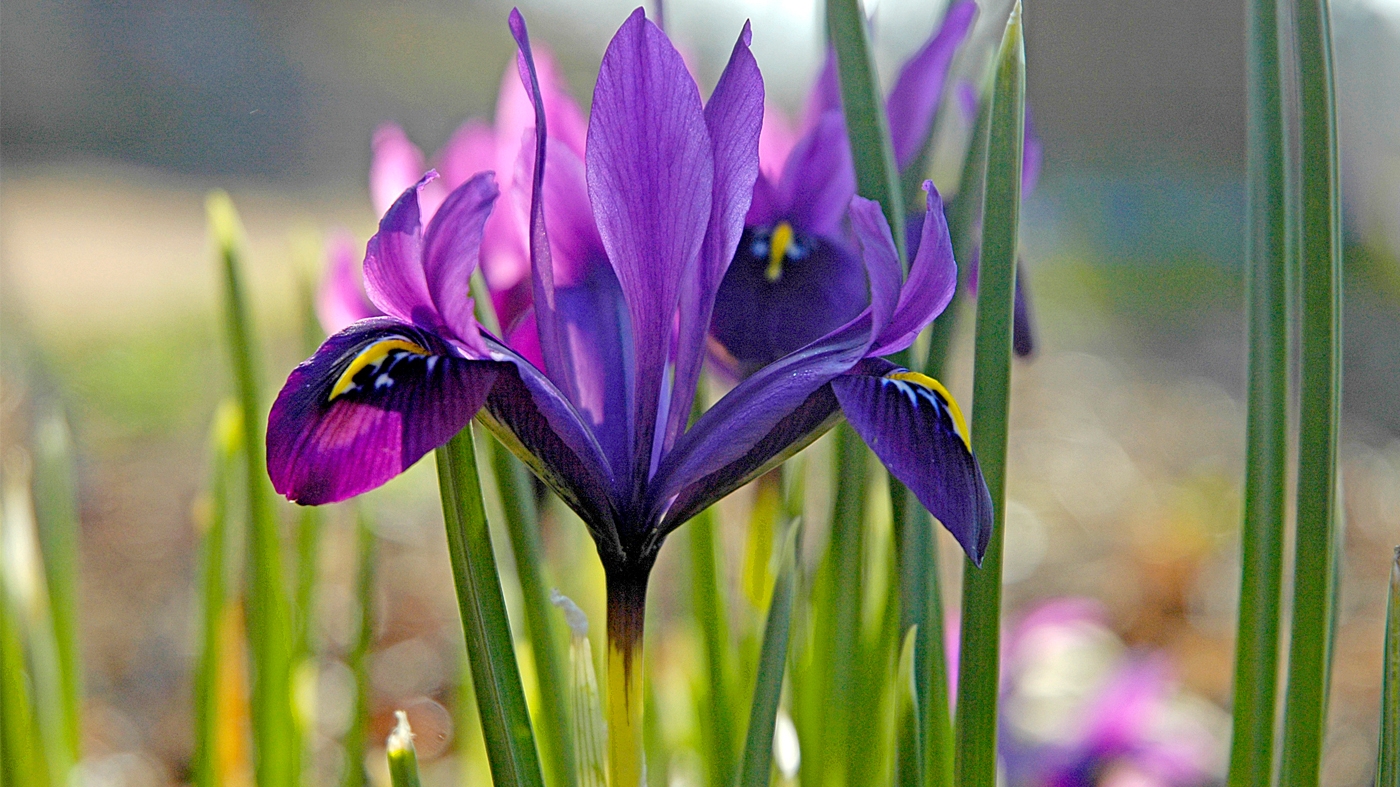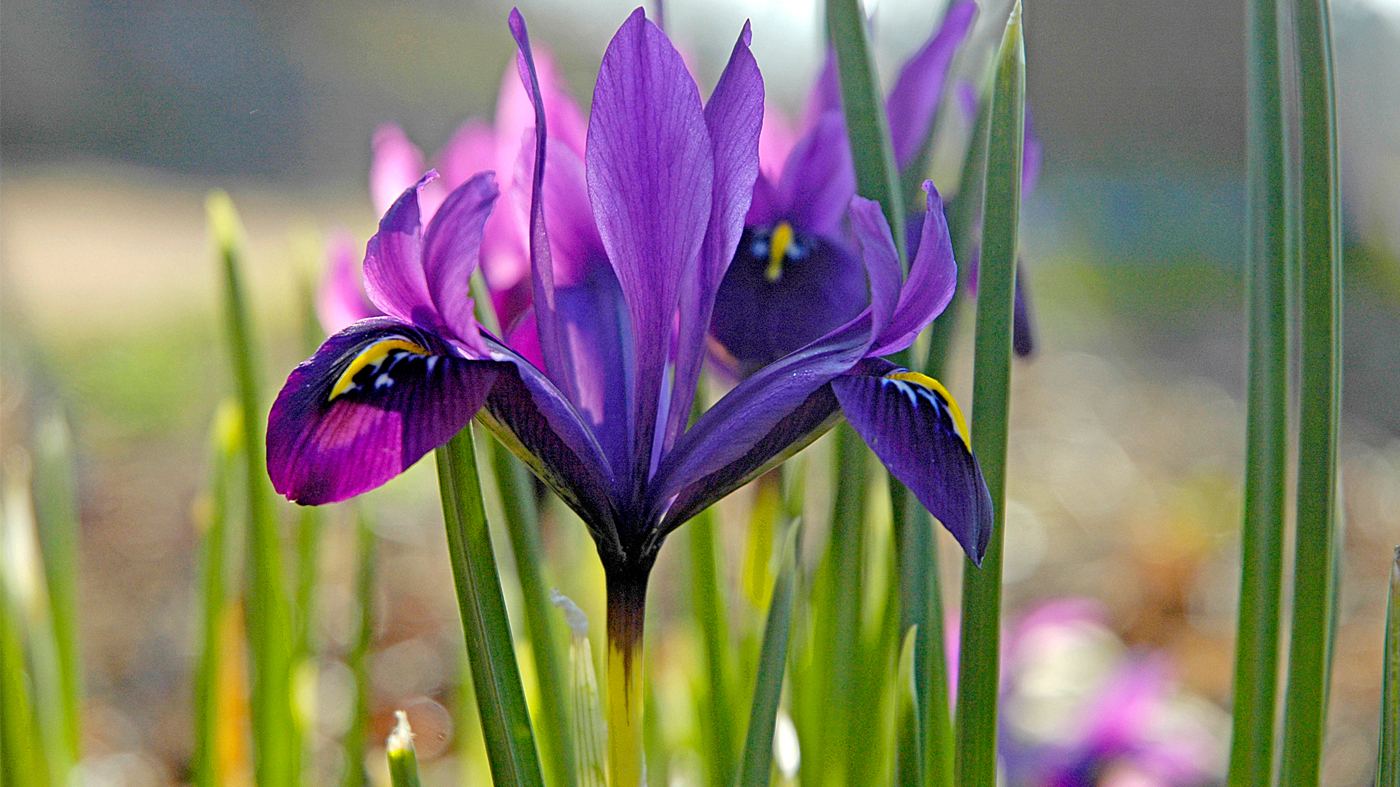

What's in Bloom
Bloom Highlights
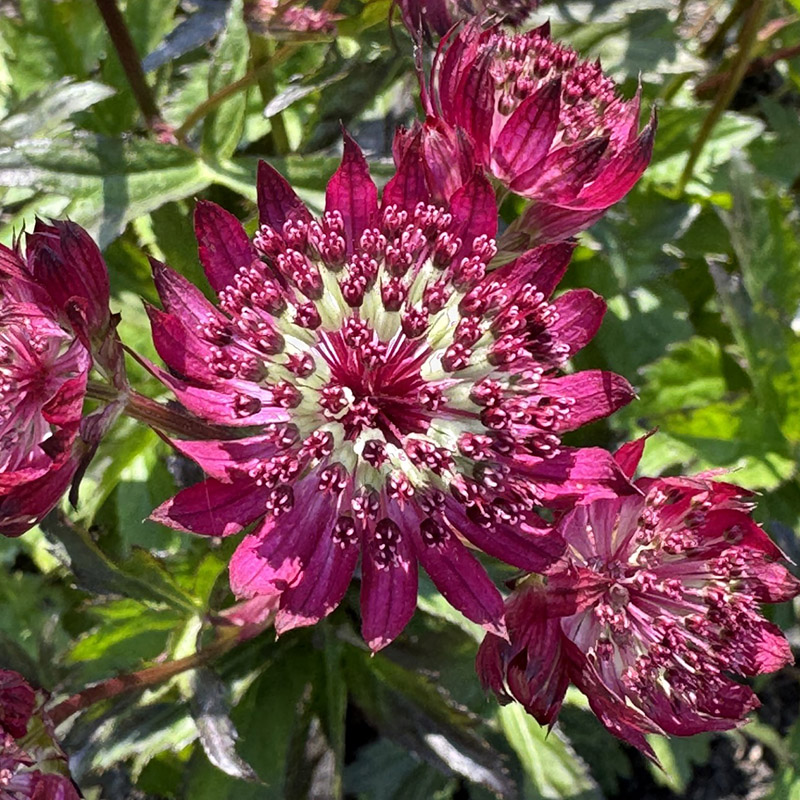
Astrantia major ‘Midnight Owl’
Midnight Owl Masterwort
Astrantia major is native to southern, central, and eastern Europe where it can be found in the mountain meadows, woodlands and by streams of the Pyrenees, Carpathian, Balkan, and Caucasus Mountain ranges. This plant forms clumping mounds of foliage and can spread via rhizomes to form colonies. The stems are smooth, erect, and exhibit little branching. The leaves are dark green and glossy. The basal rosette of leaves have long petioles with three to seven toothed palmate lobes and are much larger than the upper leaves which are sessile to the stem and lanceolate with three toothed lobes. The stems terminate with an umbel inflorescence subtended by large, papery, petal-like bracts. The tiny, star-like flowers are concentrated in a dome in the center. Each flower has greenish, tubular sepals and pink petals, stamens, and pistils; however, this cultivar is noted for its burgundy floral bracts with matching flowers. The genus name has two possible origins: (1) the name derives from the Greek word asteron meaning “star,” in reference to the shape of the flower head; or (2) from the Latin word magistrantia, meaning “master” or “teacher” due to its historic use in folk medicines. The specific epithet means “large” in Latin as it is larger than Astrantia minor but smaller than Astrantia maxima.

Baptisia australis
Blue Wild Indigo
A North American native, this plant’s native range includes Pennsylvania in the north, south along the plains of the Appalachian piedmont to northern Georgia, and westward into the central Mississippi River valley. It is commonly found in prairies, open woodlands, and along stream banks. This plant forms upright mounds of foliage supported by many stiff, smooth stems that elevate the foliage off the ground. The cool green leaves are trifoliate and slightly pubescent with elliptic to oval leaflets with smooth margins. In early summer, the stems produce terminal, erect racemes inflorescences with many lupine-like flowers. The flowers have five dark green, almost black, fused sepals. The five petals are arranged so that the two upper purply-blue petals reflex back forming a banner across the top of the flower and two more purply-blue lateral petals nearly clasp to hide the keel petal that is usually greenish-white. After blooming, the ovary inflates into a large, showy seed pod that darkens to charcoal black and dries. The genus name is derived from the Greek word baptízo meaning “to dip, plunge, immerse” as in fabric into dye for which this plant is used. The specific epithet is Latin for “southern” in reference to the native range.

Layia platyglossa
Coastal Tidy Tips
This plant is native to the San Francisco Bay region southward along the coast to Baja California, Mexico where it is found in the grassy coastal plains and open pine forests. This plant forms mounds of open foliage due to its highly branching, erect stems. The pubescent stems are bright green and alternately bear sessile, linear to oblong leaves. The lower, older leaves develop shallow, pinnately lobed margins while the upper, younger leaves are either minutely lobed or unlobed. The plants produce flower heads from the stems’ terminus and from leaf axils. The flower heads have a ring of large, flat ray florets with three to five yellow fused petals that fade to white at the apices of the petals. The center of the flower heads has a button of golden yellow, star-like disc florets. The flower heads are subtended by bracts. The genus was named to honor George Tradescant Lay, a British diplomat, missionary, and naturalist, as he is credited for discovering the genus. The specific epithet comes from the Greek words platý meaning “wide” or “flat” and glóssa meaning “tongue” in reference to the shape of the petals.
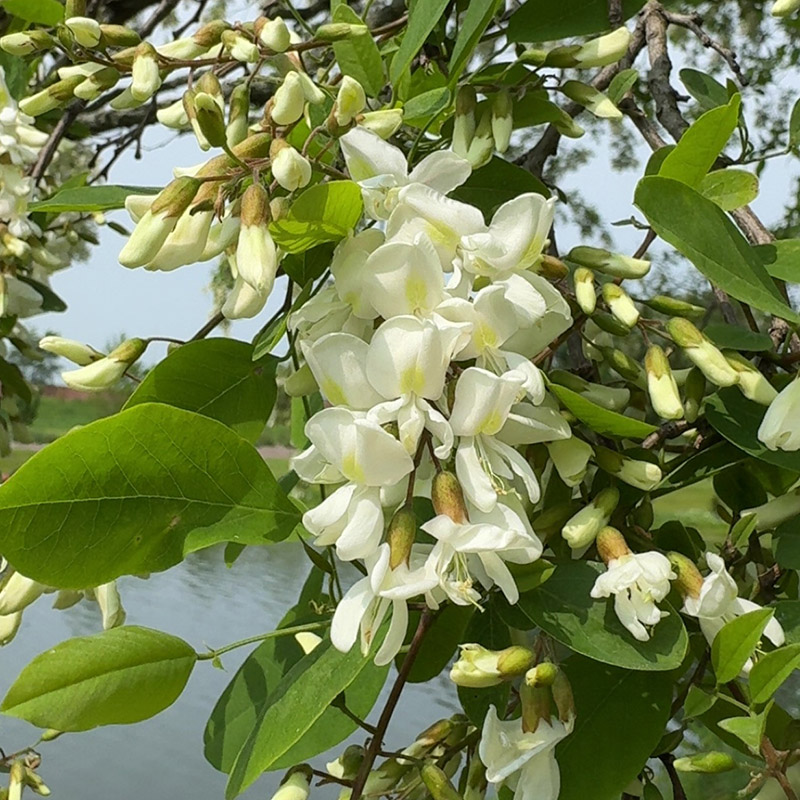
Robinia pseudoacacia ‘Unifolia’
Oneleaf Black Locust
Robinia pseudoacacia has two disjunct native regions in the United States. The eastern range covers the Appalachian Mountains from central Pennsylvania south to northern Georgia and Alabama while the western range covers the Ozark Plateau and Ouachita Mountains of Missouri, Arkansas, and Oklahoma though the species has naturalized in areas that bridge the gap. It is found in open woodlands and forest with moist limestone soils. This deciduous tree has an upright oval to rounded habit. The bark varies in color from light brown to dark grey but always has a deeply furrowed, scaly texture. The branches of the species bear spines and thorns but are otherwise smooth. The leaves of the species are dark blue-green and pinnate with up to 23 leaflets. New growth produces pendulous racemes of white, fragrant, pea-like flowers. Each flower has five fused sepals and five white petals. The upper two are reflexed back and have a blush of yellow at their bases while the two lateral petals and the lower keep petal loosely conceal the stamens and pistil. This cultivar is noted for its spineless and thorn branches, shortened leaves with a dominant terminal leaflet, and relatively smaller stature. The genus was named to honor the French herbalist and arborist Jean Robin. He is credited as the first person to plant a Robinia tree in Europe. The specific epithet comes from the Greek word pseudo, meaning “fake” or “false,” and the genus Acacia (which derives from a Greek word meaning “point”), since this species resembles species from the Acacia genus.
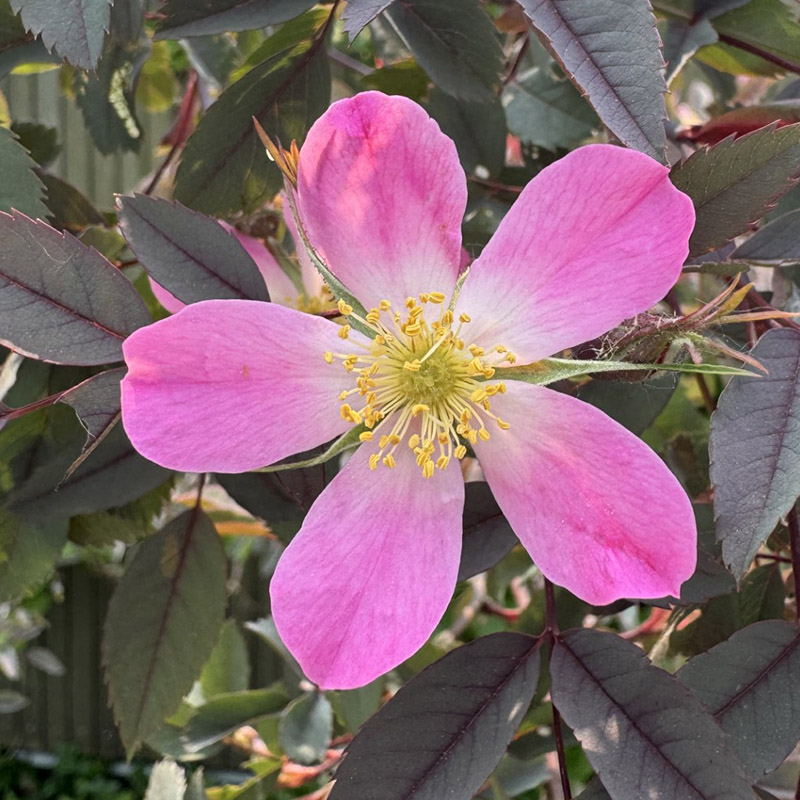
Rosa glauca
Redleaf Rose
Native to the mountainous areas of southern and central Europe, this plant is found in mountain meadows and in thickets of rocky slopes. It is a deciduous shrub with arching cane stems. The young stems are dark red and mature to deep brown with red and orange undertones. The young stems bear pinnately compound leaves comprised of five lanceolate to ovate leaflets with serrate margins. The leaves are a distinctive dark blue-green with dark red midvein, rachis, and petiole and are covered in a waxy bloom. In addition to the leaves, the stems sparsely produce epidermal prickles which are colloquially referred to as thorns. From the leaf axils and terminus of the new growth stems, abundant small, solitary flowers are produced. Each flower has five dark green, lanceolate sepals with long white hairs, five bright pink petals that are white at their bases, a ring of many pale yellow stamens around a button of many tiny pistils. In the autumn, the ovary of each flower ripens from dark purplish-green to red-orange and becomes a globose hip. The genus name is the Latin that comes from the Greek word rhódon meaning “rose.” The specific epithet comes from Latin meaning “waxy” or “bluish-green” referring to the leaves.
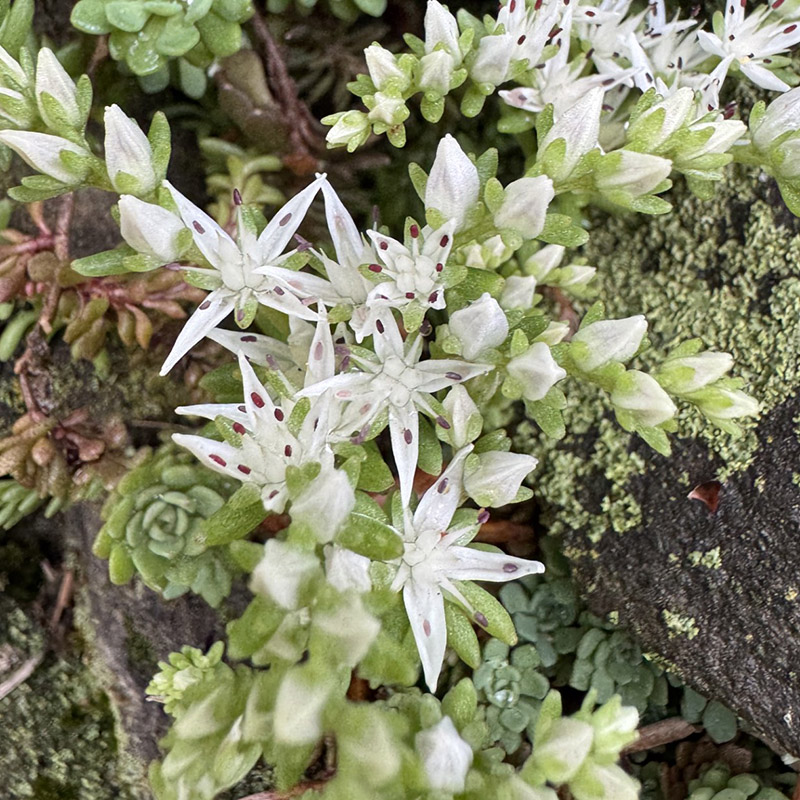
Sedum glaucophyllum
Cliff Stonecrop
This plant is native to the central Appalachian Mountains of Maryland, West Virginia, Virginia, and North Carolina where it is found in lightly shaded areas of rocky slopes, outcrops, and cliffs where it grows in the cracks and gaps forming mats. The stems are trailing and highly branched forming terminal rosettes of succulent leaves. The young leaves start nearly upright, parallel to the stem, but as they mature and expand they spread out to be perpendicular to the stem. The pale green leaves are glaucus appearing bluish-green and are oblanceolate to spatulate in shape. Floral stalks are erect, unbranching, bearing small linear succulent leaves, and are produced from the leaf axils of mature leaves of the rosette. These stalks terminate in a cyme inflorescence of five to thirty small white flowers. The flowers have four, rarely five, fleshy green sepals. Alternate to the sepals are four, rarely five, pointed, awl-like petals that spread out beyond the apices of the sepals. Eight stamens line up with the positions of the sepals and petals and have white filaments topped by dark red or purple anthers. At the center of each flower are four small, bulbous pistils are positioned aligned with the petals. The genus name comes from the Latin verb sedere meaning “to sit” in reference to how many species in this genus trail along or “sit on” the ground. The specific epithet comes from the Latin word glaucus meaning “waxy” or “bluish-green” and the Greek word phýllon meaning “leaf” describing the texture and color of the leaves.
